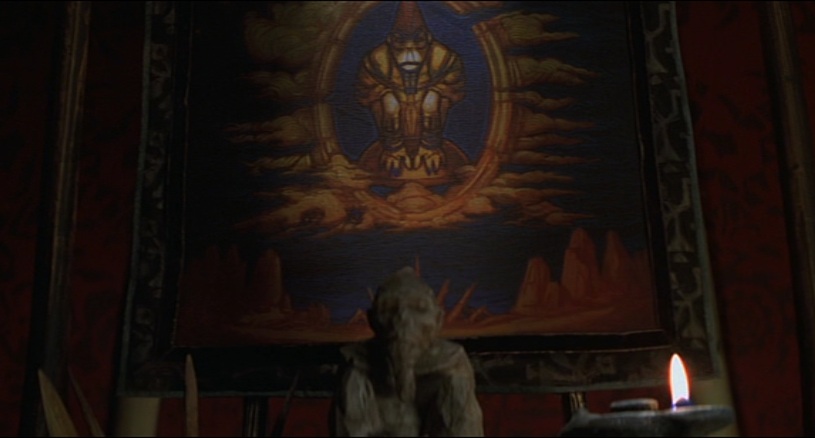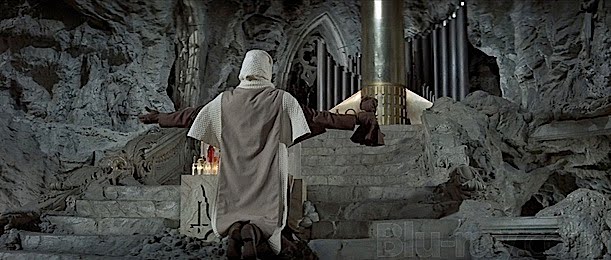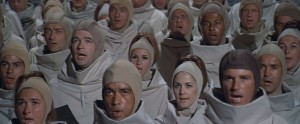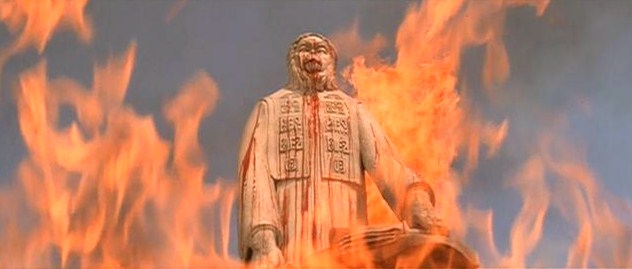Last weekend I had AMC channel on for most of the day as they celebrated the 45th anniversary of Planet of the Apes which debuted in 1968. During their celebration, AMC played each of the films in the original franchise of the 1960s-70s back to back. I am a lifelong fan of the series having first experienced “ape mania” in the 1970s, but this was the first time I watched them in this way. It provided an opportunity to more carefully see the development in the films, and in the process one item stuck out for me as some of the films addressed religion. What type of religion is found over the course of almost five decades of Apes franchise history?
Although there are seven films in the series that are related to the founding mythology of the 1968 film, only three of them incorporate religion in significant ways. This includes Planet of the Apes (1968), Beneath the Planet of the Apes (1970), and Planet of the Apes (2001). Surprisingly, although the first two films of the franchise were produced close together, they represent a diversity of religion almost as far away from each other as they are in the depiction of it in Tim Burton’s film decades later.
The first film in the Apes saga depicts a futuristic society of intelligent apes that have created a culture that echoes the human culture from which it sprang (we learn at the end of the film). This includes a number of aspects, including not only politics, the military, and science, but also religion. Religion is featured as both a background and important foreground feature in the original film. As a background element, when Taylor (Charleton Heston) is trying to free himself from his ape captors he runs through Ape City. At one point he hides in a building where a funeral service is going on. An ape minister is leading the service, and an ape-shaped casket is visible in the front. In the film’s dialogue in this scene we hear the minister providing a eulogy that sounds very similar to what is heard in human funerals as the deceased, whatever their actual character, is described in glowing terms. Elsewhere in the film religion is portrayed as an important foreground item. It is present through Dr. Zaius (Maurice Evans), who is both the Minister of Science and Defender of the Faith. The form of religion among the apes, zealously protected by Zaius, resembles Christian fundamentalism as the tension if not outright contradiction between the findings of archaeology, evolutionary science, and the history of the “Sacred Scrolls” is evident. The cultural battles of modernity in the form of creation versus evolution is clearly evident throughout the film, but this dialogue between Taylor and Zaius expresses it most clearly:
Taylor: There’s your Minister of Science; honor-bound to expand the frontiers of knowledge…
Dr. Zira: Taylor, please!
Taylor: …except that he’s also chief Defender of the Faith!
Dr. Zaius: There is no contradiction between faith and science… true science!
In this dialogue segment one can clearly hear the voice of young-earth creationists who quickly dismiss what they would consider the “alleged evidences” of geology, anthropology, biology, and genetics in favor of a particular interpretation of their sacred scrolls, the creation stories in Genesis. Other suggestions of a Christian fundamentalism are also present, but the religious figure of The Lawgiver, developed more fully in the next film in the franchise, portrays an ape prophet similar to Moses. When these elements are taken together the religion of Planet of the Apes can be understood as a critique of Judeo-Christian fundamentalism.
The next film in the franchise that depicts religion makes it an important element, and increases the fundamentalist aspect significantly, even while adding additional aspects. In Beneath the Planet of the Apes we learn that a group of humans survived the nuclear war that devastated a large segment of the planet, contributing a reverse process of evolution, creating The Forbidden Zone desert, and forcing human beings underground. The surviving humans are badly scarred by the effects of the war, not only showing physical harm as irradiated mutants possessing psychic powers, but also in the form of a system of worship based upon the atomic bomb.
This film devotes far more screen time and plot elements to religion, and in particular this strange form of nuclear church. It includes an extensive scene depicting an act of community worship in a cathedral type of structure with congregants, a choir, a music minister playing an organ, a hymnal, a worship leader, a liturgy, and an object of worship at the front of the cathedral: a shining, gold nuclear missile. This is a doomsday bomb inscribed with the Greek letters of alpha and omega, the first and last or beginning and ending letters. This connects the bomb to the Christian tradition in its depiction of God, and more specifically, Christ in the book of Revelation, who is described as the Alpha and Omega.
The leader of these nuclear mutants has a name that recalls papal titles, Mendez XXVI, and the liturgy he recites for the group, no doubt incorporating some of this religious community’s sacred text, includes echoes of biblical imagery of creation and eschatological destruction, and is also reminiscent of Christian liturgy.
“Glory be to the Bomb, and to the Holy Fallout. As it was in the beginning, is now, and ever shall be. World without end. Amen.” – Mendez XXVI
The form of religion portrayed in Beneath the Planet of the Apes is in some ways another form of Christian fundamentalism. It features a zealous group of people with a strong sense of persecution, it has a clearly identified enemy, and it incorporates eschatological or “end times” elements. Indeed, the eschatology is the primary and foundational element, as the group not only look forward to the end and a resulting new order (even if it is destruction), but worships a nuclear weapon as the tool that will bring this about. But with these fundamentalist elements we also find a fusion of other aspects such as a cathedral setting for worship, a religious heirarchy, and a strong sense of liturgy. Given these elements a Roman Catholic sensibility is present, indicating that the religion of Beneath is best understood as a fusion of Catholicism and Protestant fundamentalism.
The combination of religion and violence is strange in this second installment in the franchise. In the first film the ape society is portrayed as peaceful and in sharp contrast with the violent history of human culture of the past. The Sacred Scrolls of the apes are quoted toward the end of the first film to make this point:
Beware the beast Man, for he is the Devil’s pawn. Alone among God’s primates, he kills for sport or lust or greed. Yea, he will murder his brother to possess his brother’s land. Let him not breed in great numbers, for he will make a desert of his home and yours. Shun him; drive him back into his jungle lair, for he is the harbinger of death.
Yet with the second film we find an increased desire for military action by the apes against the humans. This call for violence begins with the gorilla military leaders through General Ursus (James Gregory ) who says, “The only thing that counts in the end is power! Naked merciless force!,” but is later sanctioned by ape religion through the orangutans who represent both religion and science. In one scene in this film, just before the gorilla forces march on the underground human city, an ape minister blesses the soldiers and pronounces divine blessing upon their pending military action. I have already discussed the human mutant form of religion, and when the ape and human expressions of religion are combined, an extremely violent and virulent rationale for evil as “sacred duty” present. Clearly the mindset of the producers of the first two installments in the Apes franchise saw religion as a dangerous cultural force.
This brings us to the third film in the franchise where religion is depicted, Tim Burton’s 2001 effort of Planet of the Apes. Several decades had past since the original films, so the cultural context is different, and therefore we should expect some similarities but differences in how religion is presented. This is indeed the case.

Like the original film, we find a strong sense of Enlightenment rationality, expressed by the character Ari (Helena Bonham Carter). She discusses the ape sacred scrolls, but quickly dismisses them as a fairytale. This skepticism is countered by the belief of the character Attar (Michael Clarke Duncan), a gorilla military leader, who expresses devotion in the form of prayer, and belief in the mythology of the sacred scrolls with its tales of a return (a “Second Coming”) of Semos, a messianic figure. In one scene Attar is adamant about the need for all, believer or skeptic, to bow their heads in prayer. And later in the film he is depicted in his tent meditating or praying before an artistic depiction of Semos. But with this Semos also takes on a slightly Buddhist flair, as the art portrait resembles mandalas and depictions of the Buddha used for mediation and worship.
Given the different cultural context of 2001, Burton’s Planet of the Apes depicts a variety of reactions to religion, from the scientifically skeptical, to the devout, with the latter resembling a mild form of Christianity with some Buddhist undertones. But even with the presence of belief, at the conclusion of the film skepticism comes to the fore. As the story unfolds the origins and relationship of apes and humans comes to contradict the sacred Semos mythology, and Attar comes to the realization that, “Everything I have believed is a lie.” As in the 1968 film, religion is present with its powerful origin story, but in the end it must ultimately be discarded when science intrudes. In this understanding of the tension between religion and science, no synthesis is deemed possible.
The Apes films represent one of the most interesting collections of science fiction films, with multiple layers of social commentary available for those willing to probe its depths. While race has been one of the areas most readily considered by film scholars and other academics, religion is also present for those interesting in considering how human religiosity might be understood in the reflection of the apes.








Many thanks to John Morehead for dealing with this aspect of the Planet of the Apes films. I found the worshipers of the A-bomb in the “Beneath” film one of the most interesting parts of any of these films. Someone once commented that the scene with them singing their version of “All Things Bright and Beautiful” must be one of the most bizarre scenes from any film.
Reading this post reminded me of a scene from an amusing satire of the Apes films in Mad Magazine (“Milking the Planet That Went Ape”). One of the mutants is explaining to the astronaut Brent that they worship an atomic bomb as their God, and he exclaims: “Boy … I sure hope I’m not here for your HIGH HOLY DAYS services!”
Carl Rosenberg
Vancouver, BC
Thanks for commenting, Carl. This was not one of my favorite Apes films, but with additional viewings it has grown on me, and this element in particular.